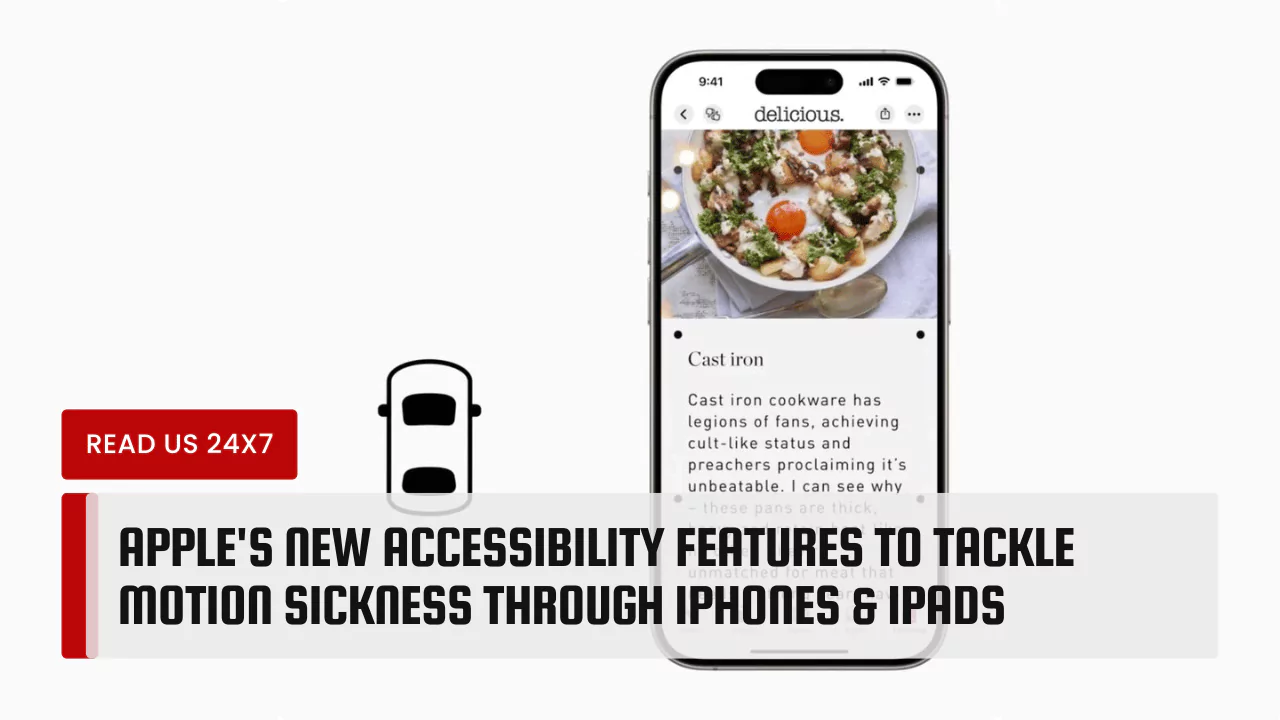Motion sickness while using smartphones in moving vehicles has been a persistent challenge for many users. The sensory conflict between what users see on their screens and what they feel in the vehicle often leads to discomfort and even nausea. Apple has recognized this issue and has come up with an innovative solution to address it.
With Vehicle Motion Cues, animated dots on the edges of the screen represent changes in vehicle motion to help reduce sensory conflict without interfering with the main content. Using sensors built into iPhone and iPad, Vehicle Motion Cues recognises when a user is in a moving vehicle and responds accordingly. The feature can be set to show automatically on iPhone, or can be turned on and off in Control Center.
Apple Explains
The Problem: Motion Sickness in Vehicles
The use of phones in cars can initiate motion sickness due to a sensory conflict between visual stimuli and physical sensations. This phenomenon, known as visually induced motion sickness (VIMS), occurs when the visual information received by the eyes conflicts with the physical sensations perceived by the body during movement.
When using a phone in a car, the visual stimuli on the screen can create the illusion of movement, while the body remains relatively stationary. This discrepancy between visual and physical input can lead to symptoms of motion sickness, including nausea, dizziness, headaches, and discomfort.
Several factors contribute to the development of VIMS. The size and brightness of the phone screen, the contrast between the screen and the surrounding environment, and the frequency of head and eye movements all play a role. Additionally, individual susceptibility to motion sickness and the duration of phone use can influence the severity of symptoms.
The discomfort associated with VIMS can make it challenging for users to comfortably use their devices while traveling. It can interfere with tasks such as navigation, communication, and entertainment, and can even pose a safety hazard if it leads to distractions or impaired driving.
To minimize the risk of VIMS, it is recommended to limit phone use while in a moving vehicle. If necessary, use the phone sparingly and take frequent breaks to allow the eyes and body to adjust. Also, adjust the screen brightness to reduce contrast and avoid using the phone in low-light conditions.
Apple’s Solution: Vehicle Motion Cues
To alleviate motion sickness for iPhone and iPad users, Apple has introduced a groundbreaking feature called Vehicle Motion Cues. These cues are designed to provide real-time feedback about changes in vehicle motion, thereby reducing the sensory conflict experienced by users.
What are Vehicle Motion Cues?
Vehicle Motion Cues are a feature designed to help reduce motion sickness when using a mobile device in a moving vehicle. Apple has announced this feature as part of its new accessibility options coming to iPhones and iPads. The concept is based on the idea that motion sickness often occurs due to a sensory conflict between what a person sees and what they feel while in motion. To combat this, Vehicle Motion Cues use visual elements on the display that indicate real-time changes in motion.
Here’s how it works: Animated dots appear on the edges of the screen and move in response to the motion of the phone or vehicle. For example, if the vehicle turns right, the dots will shift across the screen to the right. This visual cue aligns with the actual motion, helping to reduce the sensory conflict that can lead to motion sickness. The feature uses sensors built into the iPhone and iPad to detect when the user is in a moving vehicle and adjusts the display accordingly. It’s a thoughtful approach to making technology more accessible and comfortable for users who experience motion sickness.
How They Work to Reduce Motion Sickness?
The primary goal of Vehicle Motion Cues is to mitigate the sensory conflict that causes motion sickness. By providing visual feedback that aligns with the user’s physical experience, these cues help synchronize the user’s visual perception with their actual motion in the vehicle. As a result, users are less likely to experience discomfort or nausea while using their devices during car rides.
The Impact of Vehicle Motion Cues
The introduction of Vehicle Motion Cues holds significant promise for iPhone users, particularly those who struggle with motion sickness. By addressing this common issue, Apple is making its devices more accessible and user-friendly for a wider audience. Additionally, the implementation of such technology highlights the potential for integrating advanced features into future car technology.
Potential Benefits for iPhone Users with Motion Sickness
For individuals prone to motion sickness, Vehicle Motion Cues offers a practical solution that enhances their overall user experience. By minimizing discomfort and enabling users to engage with their devices more comfortably during travel, Apple is empowering users to make the most of their devices in various settings.
Future Implications for Car Technology
Beyond addressing motion sickness, the development of Vehicle Motion Cues underscores the potential for collaboration between tech companies and automotive manufacturers. As smartphones continue to play a significant role in daily life, integrating features like Vehicle Motion Cues into vehicle interfaces could lead to safer and more enjoyable experiences for drivers and passengers alike.



